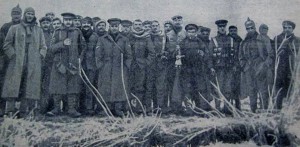(Photo: Daily Mirror January 1915)
The 1914 Truce in Context – A summary of “Trench Warfare 1914 – 1918: The Live and Let Live System”, Tony Ashworth (Macmillan, 1980)
By; Stuart.
It wasn’t in fact a bolt from the blue. Instead the 1914 Truce was part of a pattern that both preceded that Christmas and continued beyond. There were ‘cushy’ sectors, involving ‘laissez faire’,‘Rest and let rest’, ‘Let sleeping dogs lie’,‘Mutual obligation element’,‘Tacit truces’, ‘mutual understanding’, ‘Compromise and be mighty glad to be alive’, running along the British front line on the Western Front. There were respected rituals during the day: Breakfast bacon and ration party truces when, as Ian Hay wrote in 1915: ‘It would be child’s play to shell …ration wagons and water carts.but on the whole there is silence.if you prevent your enemy from drawing his rations…he will prevent you from drawing yours.’
In addition, both sides faced General Winter. A German officer commented in 1914: ‘Friend and foe alike go to fetch straw from the same rick to protect them from the cold and rain and to have some sort of bedding to lie on – and never a shot is fired.’ Sometimes, defused rifle grenades were tossed into trenches containing messages, (sometimes ‘weather truces’), and led to salutations, conversations and jokes, (‘”Waiter!”… fifty Fritzes stuck their heads up…”Coming Sir.” ’).
Sometimes, a deliberate policy of positive inertia was recognized and reciprocated, sometimes night patrols would studiously avoid each other. Weaponry, even when used, could also send messages: Rifle and machine gun fire might be aimed too high, and hand planted bombs or thrown grenades would be misplaced or misdirected respectively to avoid hits on the enemy. This was an invitation to reciprical action by the other side and the practice was a recognition that with ‘their trenches…no more than ten or fifteen yards from ours…the mildest exchange of hand grenades or bombs…Would have made life intolerable.’)
Heavy artillery took a different approach where messages were sent by the fact that often the same spot would be shelled at exactly the same time each day:
‘Twelve little Willies at noon to the tick,
Got our heads down, and go them down quick,
Peaceful and calm was the rest of the day,
Nobody hurt and nothing to say’
All in all, the evidence gathered and presented by Ashworth leads him to conclude:
“Altogether it does not seem unreasonable to assert that ‘live and let live’ occurred in about one third of all trench tours made by all divisions within the British Expeditionary Force. Such was the scale of this undertone of trench warfare.”
This ignored and forgotten history is almost certain to be completely ignored or dismissed in the official marking of the centenary of WW1. This hidden history, and many more such, are what we hope to bring to light.
Stuart’s blog on the radical history of the Stroud Valleys can be found here.

We note the inhumanity of the politicians and generals that send young men and women off to war for their own purposes. The wasteful damage done to the minds and bodies of our brave young people. To hold onto land and markets that mean nothing to the average person until we are told we should care and what’s more we should be prepared to pay any price for holding onto past dreams of Britain ruling the world and the rights of big businesses to trade wherever they feel they need or want to. We are the ones who are looking into the eyes of their enemies and making the ultimate decision of who lives and who dies. Many of the men at the front in World War 1, seemed to understood that war can only have boundaries if they put them there and that maybe they had a lot more in common with the soldier next to them and the “enemy” facing them than the people who put them there in the first place.